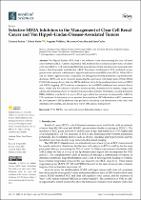| dc.contributor | Vall d'Hebron Barcelona Hospital Campus |
| dc.contributor.author | Vieito , Maria |
| dc.contributor.author | González Rodríguez, Macarena |
| dc.contributor.author | Suárez, Cristina |
| dc.contributor.author | Valdivia Bustamante, Augusto |
| dc.contributor.author | Carles, Joan |
| dc.date.accessioned | 2023-08-23T08:41:27Z |
| dc.date.available | 2023-08-23T08:41:27Z |
| dc.date.issued | 2023-06-30 |
| dc.identifier.citation | Suárez C, Vieito M, Valdivia A, González M, Carles J. Selective HIF2A Inhibitors in the Management of Clear Cell Renal Cancer and Von Hippel–Lindau-Disease-Associated Tumors. Med Sci (Basel). 2023 Jun 30;11(3):46. |
| dc.identifier.issn | 2076-3271 |
| dc.identifier.uri | https://hdl.handle.net/11351/10138 |
| dc.description | Belzutifan; Càncer renal de cèl·lules clares; Càncer de ronyó |
| dc.language.iso | eng |
| dc.publisher | MDPI |
| dc.relation.ispartofseries | Medical Sciences;11(3) |
| dc.rights | Attribution 4.0 International |
| dc.rights.uri | http://creativecommons.org/licenses/by/4.0/ |
| dc.source | Scientia |
| dc.subject | Ronyons - Càncer - Tractamemt |
| dc.subject | Medicaments antineoplàstics - Ús terapèutic |
| dc.subject.mesh | Kidney Neoplasms |
| dc.subject.mesh | /drug therapy |
| dc.subject.mesh | Antineoplastic Agents |
| dc.subject.mesh | /therapeutic use |
| dc.title | Selective HIF2A Inhibitors in the Management of Clear Cell Renal Cancer and Von Hippel–Lindau-Disease-Associated Tumors |
| dc.type | info:eu-repo/semantics/article |
| dc.identifier.doi | 10.3390/medsci11030046 |
| dc.subject.decs | neoplasias renales |
| dc.subject.decs | /farmacoterapia |
| dc.subject.decs | antineoplásicos |
| dc.subject.decs | /uso terapéutico |
| dc.relation.publishversion | https://doi.org/10.3390/medsci11030046 |
| dc.type.version | info:eu-repo/semantics/publishedVersion |
| dc.audience | Professionals |
| dc.contributor.organismes | Institut Català de la Salut |
| dc.contributor.authoraffiliation | Vall d’Hebron Institute of Oncology (VHIO), Barcelona, Spain. Servei d’Oncologia Mèdica, Vall d’Hebron Hospital Universitari, Barcelona, Spain |
| dc.identifier.pmid | 37489462 |
| dc.rights.accessrights | info:eu-repo/semantics/openAccess |

